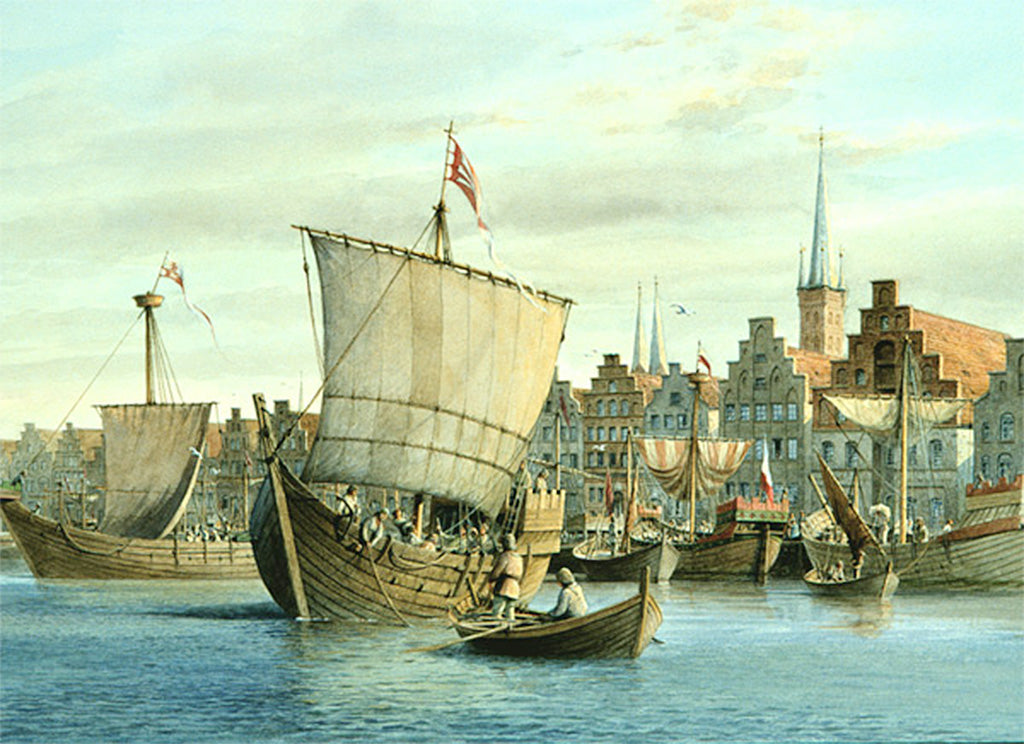The Hanseatic League

The Hanseatic League was an economic alliance of trading cities and their merchant guilds that dominated trade along the coast of Northern Europe. It stretched from the Baltic to the North Sea and inland during the Late Middle Ages and early modern period (c. 13th–17th centuries).
The League was created to protect commercial interests and privileges granted by foreign rulers in cities and countries the merchants visited. The Hanseatic cities had their own legal system and furnished their own protection and mutual aid. Despite this, the organization was not a city-state, nor can it be called a confederation of city-states; only a very small number of the cities within the league enjoyed autonomy and liberties comparable to those of a free imperial city.
Estonian and Latvian cities reaped huge profits from Hanseatic trade. Their connections to the Hansawere stronger than Lithuanian contacts because there were a large proportion of Germans in Livonia.Lithuania, on the other hand, retained its independence as the Grand Duchy of Lithuania and eventually came under Polish rule. German settlers were unwelcome in Lithuania and local peasants had more control over their own lands and product than in Livonia, where higher profits could be made byHansamerchants. Nonetheless, the Grand Duchy of Lithuania was an important supplier of agricultural products and forest products from the banks of the Daugava to the Hansathrough the Livonian Hansaport at Riga..
Lübeck in northern Germany became a main base for merchants from Saxony and Westphalia trading eastward and northward. Well before the term Hanse appeared in a document (1267), merchants in different cities began to form guilds or Hansa with the intention of trading with towns overseas, especially in the economically less-developed eastern Baltic. This area was a source of timber, wax, amber, resins, furs, along with rye and wheat brought down on barges from the hinterland to port markets. The towns raised their own armies, with each guild being required to provide levies when needed. The Hanseatic cities came to each other's aid, and commercial ships often had to be used to carry soldiers and their arms.
Lübeck's location on the Baltic provided access for trade with Scandinavia and Kiev Rus, putting it in direct competition with the Scandinavians who had previously controlled most of the Baltic trade routes. A treaty with the Visby Hansa put an end to competition: through this treaty the Lübeck merchants also gained access to the inland Russian port of Novgorod, where they built a trading post or Kontor. Other such alliances formed throughout the Holy Roman Empire. Yet the League never became a closely managed formal organisation. Assemblies of the Hanseatic towns met irregularly in Lübeck for a Hansetag (Hanseatic Diet), from 1356 onwards, but many towns chose not to send representatives and decisions were not binding on individual cities. Over time, the network of alliances grew to include a flexible roster of 70 to 170 cities.
Riga joined the Hanseatic League in 1282, and become the first Hanseatic City in Livonia. Tallinn was the next Livonian city to join the group. In Lithuania, local merchants were subject to the laws of the grand Duchy of Lithuania and were free to conduct trade with Hansa merchants, but the Hansa merchants found it difficult to secure a monopoly on Lithuanian trade. The Grand Duchy of Lithuania was hostile to the Germans after attempts at conquest. Tariffs were exacted at the Lithuanian borders with Poland and Livonia. Hansa merchants were tolerated, if they paid their tariffs, and developed trade routes through Lithuania all the way down to the Bug river where the Ukraine is today.
At the start of the 16th century, the League found itself in a weaker position than it had known for many years. The rising Swedish Empire had taken control of much of the Baltic. Denmark had regained control over its own trade, the Kontor in Novgorod had closed, and the Kontor in Bruges had become effectively moribund. The individual cities which made up the League had also started to put self-interest before their common Hanseatic interests. Finally, the political authority of the German princes had started to grow—and so to constrain the independence of action which the merchants and Hanseatic towns had enjoyed. By the late 16th century, the League had imploded and could no longer deal with its own internal struggles, the social and political changes that accompanied the Protestant Reformation, the rise of Dutch and English merchants, and the incursion of the Ottoman Empire upon its trade routes and upon the Holy Roman Empire itself. Only nine members attended the last formal meeting in 1669 and only three (Lübeck, Hamburg and Bremen) remained as members until its final demise in 1862.
Extract from an article appearing on VilNews
See the article in full.



